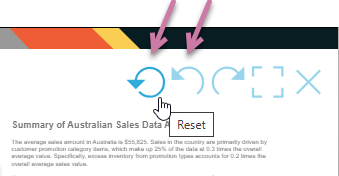When somebody designs a presentation, they typically add visuals, dynamic assets, slicers and so on that they want you to be able to interact with at runtime. You, the runtime user, can then select the elements from a slicer, in a discovery, or in another visual to highlight, sync, or filter the data in the other visuals or in the dynamic assets. The interactive changes you make in one visual are automatically reflected in the other visuals on the slide or even "cross-slide," allowing you to explore the meaning of your underlying data.
Note: Your presentation can include different types of interactions on the same slide. For example, you may have different discoveries on a single slide that contain the same items or that contain different items. The interactions, in this case, will typically:
- Cross-highlight where the visuals contain the same items; that is, when I select a manufacturer in visual 1 the same manufacturer is highlighted in visual 2.
- Cross-filter where the visuals contain different items; that is, when I select a manufacturer in visual 1, but visual 3 doesn't include manufacturer details, visual 3 is filtered by manufacturer.
For example, selecting promotion slices in a pie chart might highlight another promotion graph. It might also filter the related data in a matrix grid to only include data that relates to those promotions.
Important: This functionality is driven by the interactions that your presentation designer adds to your slides. Where there are no interactions between the different discoveries or dynamic assets, selecting a hierarchy or member element simply highlights the selected item.
Examples of Runtime Interactivity
Cross-highlighting
Cross-highlighting allows users to select hierarchies or member elements in one discovery to highlight those same items in other discoveries. Selecting a hierarchy or element in a source discovery highlights exactly the same hierarchy or element in any target discovery that is connected by a highlighting interaction. This is sometimes referred to as linking or highlighting.
- Click here for examples of cross-highlighting
Cross-filtering
Cross-filtering, or brushing, allows users to select hierarchies or member elements in one discovery to filter the content in the other discoveries by the selected hierarchies or member elements. Filtering applies where different hierarchies or member elements appear in the other discoveries on this slide.
- Click here for examples of cross-filtering
Syncing
Syncing enables synchronization between discoveries. This means that a query or data point interaction that is applied to one discovery is also applied to another discovery where the two discoveries share both a common hierarchy and a Sync interaction. For example, eliminating a data point on one visual at runtime causes the same data point on the other visual to also be eliminated if they are connected by a sync interaction.
- Click here for example Sync interactions
Common functions and information
Multi-select highlighting
When you interact with your presentation at runtime, it is often useful to select multiple elements in your visuals at one time. For example, you may want to select two similar promotion types in your pie chart to highlight the same information in another visual, such as a grid, or to filter related information with reference to those two similar options.
- Click here for more information about multi-select highlighting
Cross-slide interactions
When you interact with your presentation at runtime, some filtering and highlighting effects may apply across your presentation rather than just across your slide. This happens where your presentation designer has added targets to enable cross-slide interactions. The effect is identical to cross-highlighting or cross-filtering within a slide, the only difference being that the source and target visuals appear in different slides and that you must use the slide navigation to view the effects.
Undo your filters and selections
When you are interacting with your presentation at runtime, you may want to clear your selections and return to your slide's initial state. You can do this by:
- Clicking one of the other visuals or discoveries on the canvas.
- Opening the Present runtime menu from the hamburger menu, and clicking Reset or Undo from there (blue arrows).
- Using Reset or Undo from your presentation's runtime options (purple arrows).


Note: Reset returns the whole slide back to its initial state, whereas Undo only reverses your last change.
Model Mapping
If you see failed interactions at runtime, this might be because you have cross-model interactions but no model mapping to allow Pyramid to know how to handle the cross-model interactions. Interactions are only supported between different models with the same structure out-of-the-box. If you see an interaction that exposes an error, you should investigate whether a model mapping is needed.
- Click here for more information about model mapping